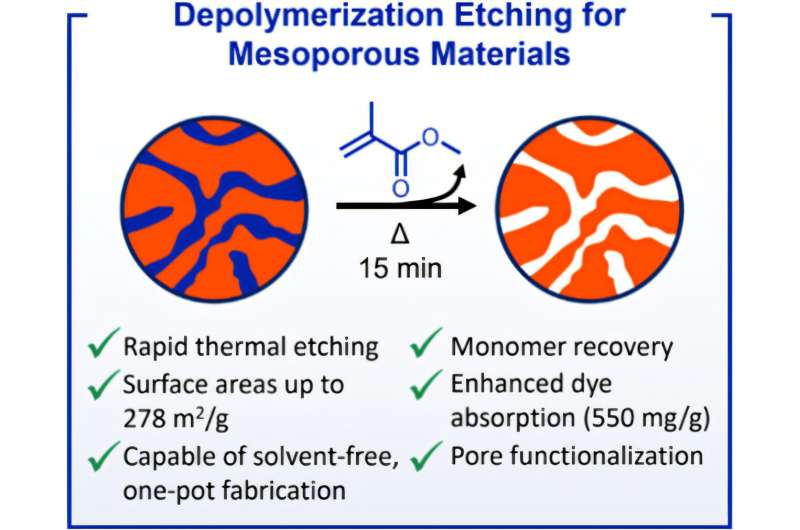Science
Chemists Unveil Innovative Method to Transform Everyday Plastics

Chemists at the University of Florida have developed a groundbreaking technique to create advanced porous materials from common plastics. This innovative method, revealed on November 4, 2025, transforms everyday materials into versatile solutions that could impact various industries, including electronics, battery manufacturing, and water purification.
The process, described by Brent Sumerlin, Ph.D., a professor of chemistry and the senior author of the report, involves a unique approach of “addition-by-subtraction.” Instead of adding components, the team removes elements from basic plastics, akin to a sculptor chiseling away stone. Sumerlin noted, “We’re sculpting from within by creating pores from inside the material, which I don’t think would be possible by any method.”
These highly porous materials are essential for applications such as battery technology and water filtration. The research team discovered that slight modifications could enable electronics manufacturers to use these materials for high-density electronic or magnetic storage devices. The findings were published in the journal ACS Central Science, showcasing the potential of this new technique.
The origins of this research lie in Sumerlin’s earlier work on breaking down plastics, a crucial step toward improving recycling processes. By identifying the varying temperatures at which different plastics break down, the team realized they could leverage this information to create new materials. In their experiments, they combined the building blocks of Plexiglass and Styrofoam, which typically do not mix well. When heated to the appropriate temperature, the Plexiglass-like components evaporated, leaving behind polystyrene and creating trillions of minuscule pores.
A mere gram of the resulting material boasts a surface area comparable to that of a full-sized tennis court. This impressive surface area is vital for advanced manufacturing processes. Sumerlin explained, “It’s like having a very small mesh in a screen, which is potentially good for purifying wastewater.” The new material also serves as a high-performance membrane, critical for battery function.
The implications of this discovery extend beyond the realm of plastics recycling. With a significant portion of the world’s energy dedicated to separating materials, this novel method may offer a sustainable solution for creating porous filters from readily available plastics. Sumerlin emphasized the broader significance of this research, stating, “This just shows how basic research in one area can inform new applications in a completely different area.”
This technique not only enhances the recycling of plastics but also opens doors to innovative applications across multiple industries. As the team continues to refine their method, the potential benefits could lead to significant advancements in technology and environmental sustainability.
-

 Sports3 weeks ago
Sports3 weeks agoSteve Kerr Supports Jonathan Kuminga After Ejection in Preseason Game
-

 Top Stories2 weeks ago
Top Stories2 weeks agoMarc Buoniconti’s Legacy: 40 Years Later, Lives Transformed
-

 Entertainment3 weeks ago
Entertainment3 weeks agoZoe Saldana Advocates for James Cameron’s Avatar Documentary
-

 Business3 weeks ago
Business3 weeks agoTyler Technologies Set to Reveal Q3 2025 Earnings on October 22
-

 Science3 weeks ago
Science3 weeks agoChicago’s Viral ‘Rat Hole’ Likely Created by Squirrel, Study Reveals
-

 Politics3 weeks ago
Politics3 weeks agoDallin H. Oaks Assumes Leadership of Latter-day Saints Church
-

 Lifestyle3 weeks ago
Lifestyle3 weeks agoKelsea Ballerini Launches ‘Burn the Baggage’ Candle with Ranger Station
-

 Lifestyle3 weeks ago
Lifestyle3 weeks agoDua Lipa Celebrates Passing GCSE Spanish During World Tour
-

 Health3 weeks ago
Health3 weeks agoCommunity Unites for Seventh Annual Mental Health Awareness Walk
-

 Health3 weeks ago
Health3 weeks agoRichard Feldman Urges Ban on Menthol in Cigarettes and Vapes
-

 Business3 weeks ago
Business3 weeks agoMLB Qualifying Offer Jumps to $22.02 Million for 2024
-

 Sports3 weeks ago
Sports3 weeks agoPatriots Dominate Picks as Raiders Fall in Season Opener









